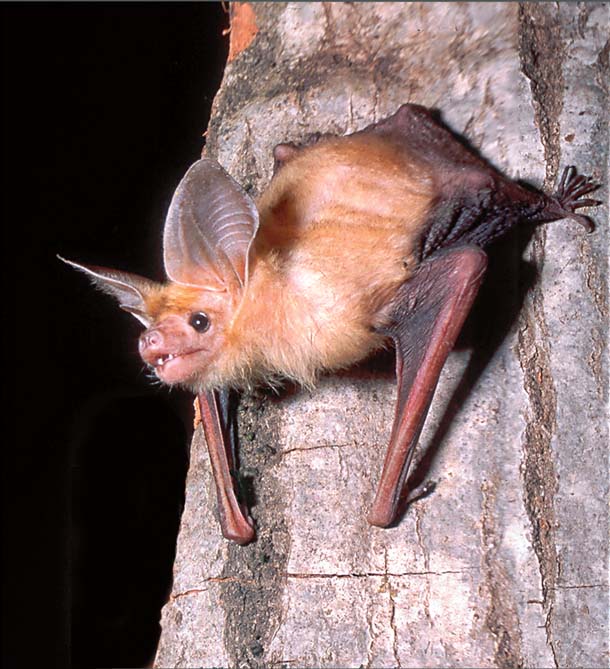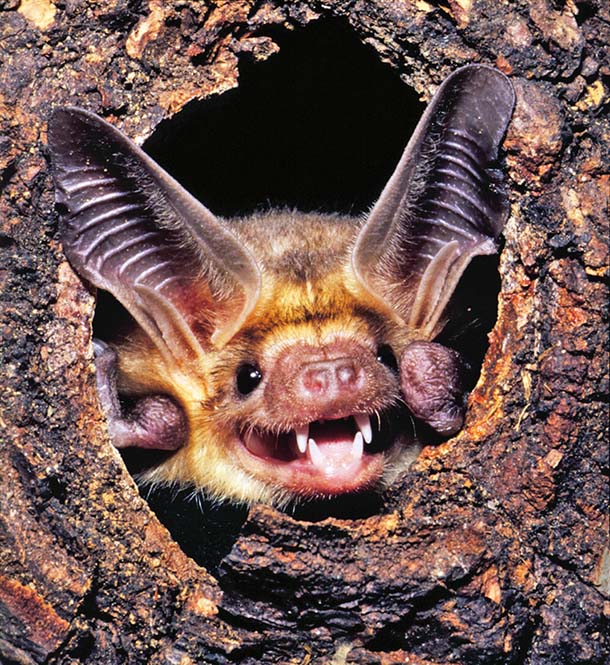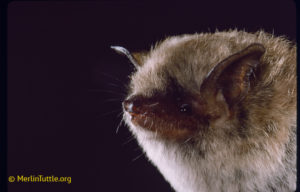You awaken, sleepily stretching your arms, but something’s wrong. . . . It’s sunset, not sunrise. And now, fully awake, you discover that your fingers have grown to extraordinary lengths! When you unfurl them, they reach down to the floor! But it’s not the floor, it’s the ceiling! Everything is upside down and you are dangling by your toes. You tighten your grip with your claws, hoping not to fall.
The ground seems a long way off. You spread your fingers again. Between them is a thin, strong double membrane of skin, which also connects your fingers to your heels and tail. Your hands have become wings. Your neighbors are stretching, grooming their fur or nursing their young–preparing for their nightly hunt. You’re part of a bat colony!
Bats become active near sunset, scrambling out of the colony on toes and hook-like thumbs. You peek outside and listen carefully, in case there’s a snake or an owl waiting. When it’s safe, you begin your nightly foraging trip.
- Many bats, like this pallid bat, roost inside trees or other protected places, emerging at sunset to hunt. Photo by Robert Bloomberg.
The hunt is on! Like most insectivorous bats, you use echolocation to navigate in the dark and locate your insect prey. Your piercing calls bounce off objects, returning to very specialized ears. This “sonar” system allows you to detect objects as large as trees or as fine as a fish fin cutting the water’s surface. You can pinpoint location, direction, and speed. But your prey won’t go down without a fight. Some moths can detect bat signals and take evasive action. Aerial chases end with the bat using its hands to scoop the insect out of the air into its open mouth.
Most bats, like the little brown bat, catch insects in midair. Some bats glean non-flying insects from the branches and leaves of trees. The western mastiff usually eats bees and wasps, but grasshoppers and dragonflies will do. Pallid bats catch bugs and even scorpions on the ground.
Bats are the only mammals capable of true flight, but your hand-wings work differently from the wings of birds and airplanes. The curve on the top of birds’ wings creates its own “lift,” allowing them to soar. Since all of a bat’s lift is generated by beating its wings against air, your wings must be larger relative to your body size. You also fly more slowly, but you can hover and maneuver well.
You’ll devour thousands of bugs tonight–large bat colonies eat tons nightly. Before dawn, you make another foray or two, swooping over ponds, lakes, and streams as aquatic insects emerge from their watery nurseries. Mayflies, mosquitoes, and caddisflies beware!

- Bats can crawl on their front arms. Pallid bats like this one even feed on insects they catch on the ground. Photo by Robert Bloomberg.
The next best thing to being a bat is seeing them. Go to a body of fresh water at sunset to look for bats against the brightest part of the sky. Western pipistrelles are among the first to come out and may even fly in daylight. For night viewing, go when there’s a good moon to see by–you may catch the silhouettes of bats skimming over the water by looking into the moon’s reflection. You may also see bats catching insects attracted by streetlights in neighborhoods near waterways. Some species hibernate locally through the winter, while others migrate or overwinter in caves or mines, so bats are best viewed during the warmer months.
Get Out!
Summer is a great time to see bats in the Bay Area. Find the Bay Area’s biggest bats at the Oakland Zoo, where Southeast Asian flying foxes spread their wings in a permanent exhibit (these bats can have a four-foot wingspan!). Visit on Feast for the Beasts day (July 11, 9 a.m.-3 p.m.) and you’ll see them and lots of other critters getting fed [hours and info: (510)632-9525, ext. 100].
If you’re in San Jose, head to the Bat Inn, a giant bat house built at Calero County Park. Stay for an evening program when hundreds of bats come out to hunt [July 18 and August 8, 6 p.m.-10 p.m. RSVP required: (408)268-3883]. Or join naturalists at Grant County Park for a bat education program on August 22 at 7 p.m. [info: (408)274-6121].
East Bay Regional Park District naturalist Cat Taylor will be hosting several bat events at Sunol Regional Wilderness–a Batty Campout for pre-schoolers (August 20-21) and a bat campfire program at Lake Del Valle [August 15, 8:30-9:30 p.m. Info: www.ebparks.org/activities, (925)862-2244]. Taylor will also lead a Bay Nature walk at Shadow Cliffs Regional Park [September 3, 6:30-8:30 p.m., with a potluck picnic at 5:45 p.m. RSVP and info].

.jpg)




